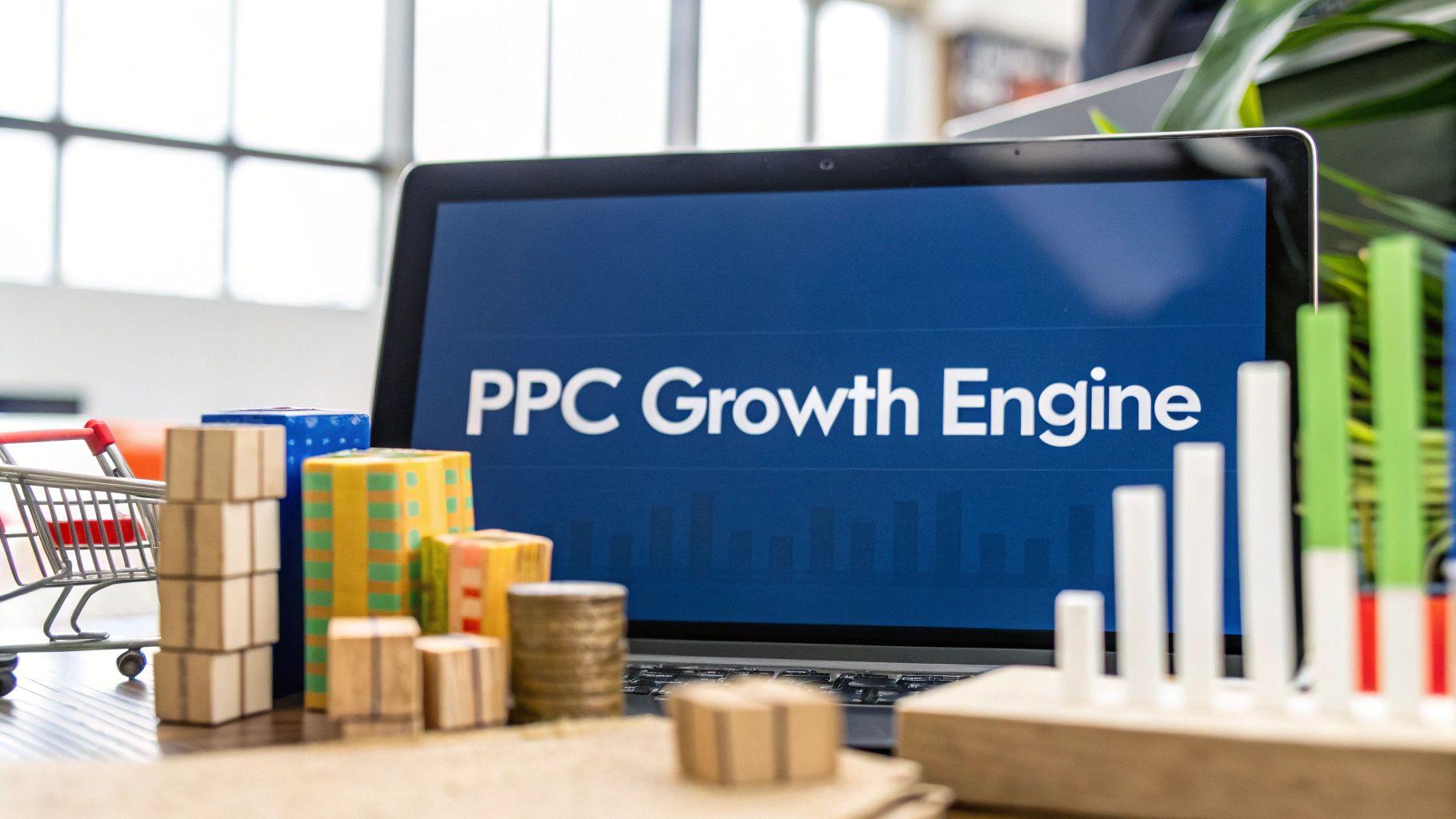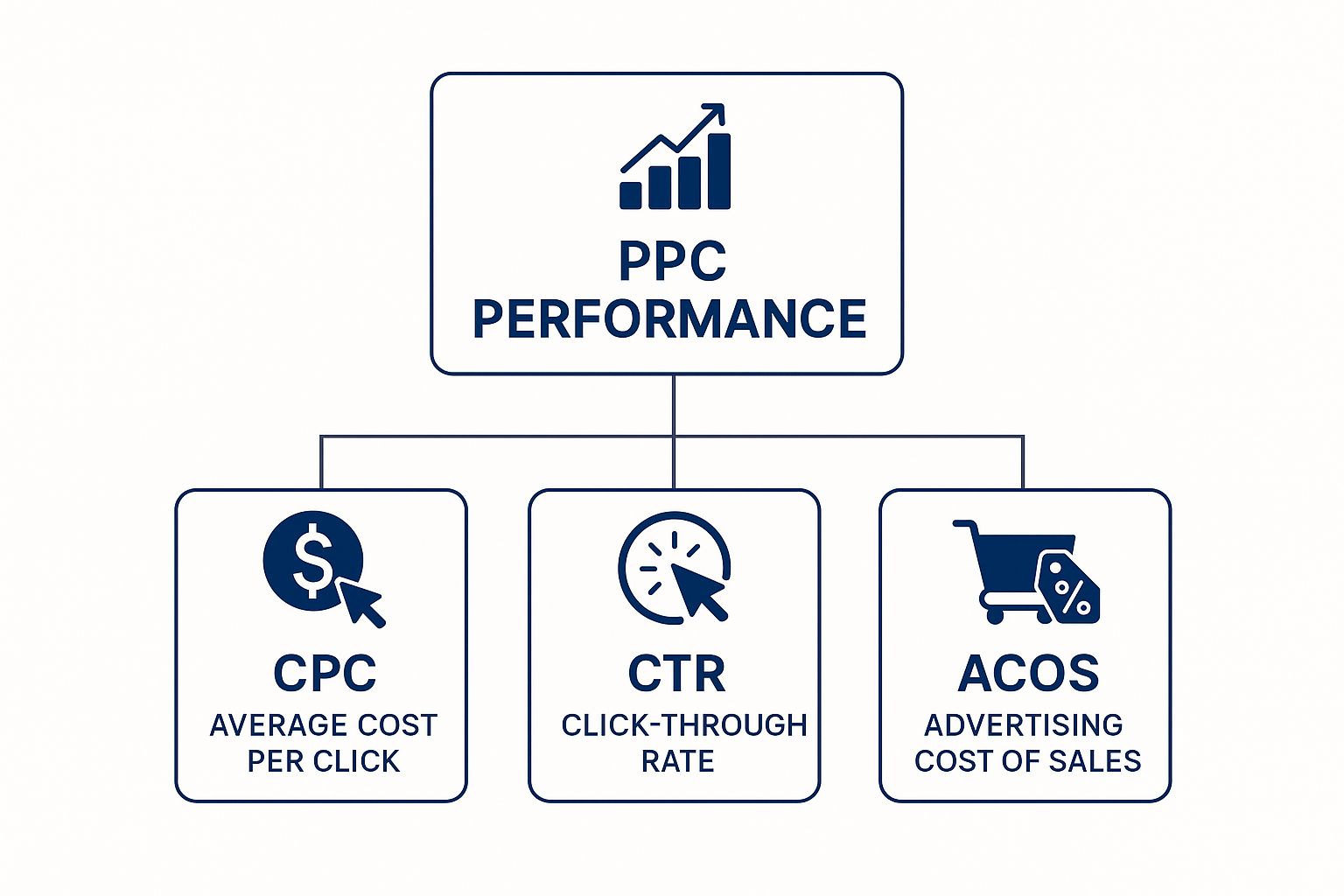Amazon PPC Management Services: From Ad Spend to Strategic Asset
Discover how strategic Amazon PPC management services drive profitable growth. Learn our performance-first approach to boost sales and organic rank.

Amazon PPC management services are no longer just an outsourced task; they are a critical partnership for brand growth. The objective isn't simply managing ad spend—it's transforming that budget from a cost center into a primary driver of organic growth, profitability, and sustainable scale. For eCommerce leaders serious about winning market share, this means moving beyond basic bid management to build a system where paid advertising directly fuels the entire Amazon flywheel.
Beyond Bids: PPC as a Lever for Organic Growth

Many brands view Amazon PPC as a necessary evil—a tax for visibility. This mindset is a direct path to unprofitable scaling. Running PPC without a holistic strategy is like filling a leaky bucket; you continuously pour budget in just to maintain visibility. Expert Amazon PPC management services, however, reframe that spend as a high-performance growth engine where every dollar is an investment.
The core principle is simple but powerful: strategic ad spend drives sales. Increased sales velocity directly improves a product's organic ranking on Amazon’s A9 algorithm. This creates the coveted "flywheel effect." As organic visibility improves, it generates more sales, reducing dependency on paid ads and increasing overall profitability. This is the mechanism that turns ad spend into a long-term asset.
Why Professional Management Is a Performance Imperative
The scale of the Amazon marketplace makes competing without a sharp, data-driven advertising strategy a near impossibility. With projections showing over 9.7 million sellers and sales rocketing past $700 billion, simply getting noticed is half the battle. This is critical when data shows that 45% of shoppers never click past the second page of search results.
Professional management ensures your products—particularly Sponsored Products—secure top-of-search placements where high-intent buyers are most active. For a deeper look into the competitive Amazon landscape, amzdudes.com offers valuable insights.
A common myth is that success is defined by a low Advertising Cost of Sales (ACoS). A performance-first approach focuses on optimizing Total ACoS (TACoS), which measures ad spend against total sales. This is the true north metric that proves your ad spend is creating a halo effect and lifting organic sales.
The Strategic Pillars of Expert PPC Services
Elite PPC management is not a "set it and forget it" function. It's an active, iterative process that leverages data to maximize the ROI of every advertising dollar.
A true growth partner will deliver on these core pillars:
- Advanced Keyword & ASIN Strategy: Moving far beyond obvious search terms to uncover high-intent long-tail keywords and competitor ASINs that drive profitable conversions.
- Granular Campaign Architecture: Building meticulously structured campaigns—segmented by match type, product lifecycle stage, and strategic objective (e.g., profitability vs. rank)—for precise budget and bid control.
- Data-Driven Bid Optimization: Using performance data and proprietary tools to make continuous, intelligent bid adjustments, ensuring you never overpay for a click and can capitalize on profitable opportunities in real-time.
- Holistic Business Alignment: Connecting PPC performance to broader business objectives, including inventory management, new product launches, and defending market share against competitors.
Ultimately, engaging an expert Amazon PPC management service is an investment in durable, profitable growth. It's about building a brand that doesn't just survive on Amazon but systematically wins in the world's most competitive marketplace.
What Does a High-Performance PPC Strategy Actually Look Like?
Top-tier Amazon PPC management transcends simple bid-tweaking. An effective strategy is a complete architecture for profitable, sustainable growth. It's not about chasing a low ACoS; it's about leveraging ad spend as a tool to improve organic rank, capture market share, and build a scalable business. This blueprint is built on three core pillars that work in concert to create a formidable advertising engine.
A successful strategy begins by defining success and linking ad performance to overarching business goals. This diagram outlines the foundational metrics—CPC, CTR, and ACoS—that serve as the starting point for any rigorous PPC analysis.

While each metric tells a piece of the story, an experienced manager understands their interplay and how they contribute to total profitability and sustainable growth—the metrics that matter to a P&L.
Advanced Keyword and Competitor Harvesting
The foundation of any winning campaign is relentless, intelligent keyword research. This is not a one-time task but an ongoing cycle of discovery, testing, and refinement. While basic tools provide keyword lists, a true growth partner digs deeper to find undervalued opportunities.
This deep dive includes:
- Mining Auto Campaigns for High-Intent Terms: Systematically identifying and graduating high-converting search terms from automatic campaigns into manual campaigns for precise bid control.
- Reverse ASIN Analysis: Analyzing top competitors' listings to identify the exact keywords driving their sales, allowing you to strategically intercept their traffic and conquest their customers.
- Leveraging First-Party Data: Utilizing Amazon's Search Query Performance data to uncover high-impression, high-click terms that aren't available in third-party tools. Our full guide on https://www.headlinema.com/blog/amazon-ppc-keyword-research breaks down these advanced techniques.
Beyond keywords, a high-performance strategy demands sharp competitor intelligence to identify both opportunities and threats. This means actively monitoring rivals' pricing, promotions, and ad placements to inform your next strategic move.
Sophisticated and Scalable Campaign Structures
Campaign architecture is as crucial as the keywords within it. A disorganized account is an unprofitable one—optimization is impossible without structure. An expert builds a clean, logical, and granular structure designed for absolute control and efficient scaling.
The goal of a sophisticated campaign structure is to isolate variables for accurate optimization. By separating campaigns by match type (Exact, Phrase, Broad), product stage (Launch, Growth, Mature), and strategic objective (Profitability, Ranking, Brand Defense), you gain precise control over every dollar of ad spend.
A "catch-all" campaign is a black box of performance data. You can't identify what's working. A structured approach enables you to confidently allocate budget to your most profitable segments and systematically eliminate waste. This methodical organization is the hallmark of a professional, performance-driven approach.
Aggressive Negative Keyword Sculpting
One of the fastest routes to improved profitability is eliminating spend on clicks that will never convert. This is the role of negative keyword sculpting: proactively telling Amazon where not to show your ads. This is not a defensive tactic; it is an offensive strategy to improve ROAS.
An effective negative keyword strategy is an active, ongoing process:
- Continuous Search Term Report Audits: Regularly mining reports to find irrelevant or poorly performing search terms that are eroding the budget. For a brand selling a "leather wallet," adding "vegan" as a negative keyword is an immediate, margin-protecting action.
- Proactive Exclusions: Building lists of known irrelevant terms from day one, such as competitor brand names (for a profitability-focused strategy) or terms for incompatible products.
- Strategic Use of Negative Match Types: Using negative phrase match to block a broad set of irrelevant searches and negative exact match to surgically remove specific, consistently poor-performing terms.
This disciplined routine ensures your ad budget is laser-focused on shoppers with high purchase intent, directly boosting your return on ad spend and protecting profit margins.
Turn Ad Clicks Into Profitable Customers

Driving clicks is the easy part. Any competent Amazon PPC management service can generate traffic. The real challenge—and where most brands hemorrhage cash—is converting those expensive clicks into profitable sales. This is where professional strategists earn their keep.
Amazon's power lies in its high-intent audience. Unlike social media scrollers, visitors on Amazon are there to buy. This inherent purchase intent is why the platform can deliver such powerful results. The data confirms this: as of May 2025, the average PPC conversion rate on Amazon is approximately 10.33%. This figure dwarfs most other e-commerce advertising benchmarks, demonstrating the potential of a well-executed campaign.
The Science of On-Page Conversion
An ad click isn't the finish line; it's the start of the race. Once a shopper lands on your product detail page, the ad has done its job. The listing must now close the sale. This is the critical handoff that determines campaign profitability.
A premier PPC service doesn't just focus on bids and keywords. They analyze the entire customer journey, diagnosing why visitors fail to add to cart or complete the checkout. They treat your product page as the ultimate sales tool it is.
Core elements they relentlessly optimize include:
- Retail Readiness: Ensuring the listing is prepared for paid traffic. This means high-quality images, at least 15 reviews with a 4-star average or higher, and consistent in-stock status. Sending paid traffic to a poorly rated or out-of-stock product is a guaranteed way to waste budget.
- Compelling Copywriting: The title, bullets, and A+ Content must anticipate and answer customer questions. Crafting compelling product descriptions is a non-negotiable step for maximizing conversion.
- Social Proof and Trust Signals: Reviews, ratings, and badges like "Amazon's Choice" are powerful trust indicators. A smart agency knows how to accelerate review generation for new products to maximize the effectiveness of launch ad spend.
Think of your ad as the invitation and your product page as the event. A compelling invitation gets people to the door, but if the event doesn't deliver on the promise, no one will stay. Your listing must fulfill the promise your ad made.
Diagnosing and Fixing Conversion Bottlenecks
Top-tier agencies use data, not guesswork, to pinpoint conversion issues. They dive deep into reports to find the leaks in your sales funnel and implement targeted fixes. For a detailed breakdown of the numbers they track, our guide on online advertising performance metrics is an excellent resource.
Here’s a real-world example:
- The Problem: A brand selling premium coffee makers has a high Click-Through Rate (CTR) but a very low Conversion Rate (CVR). Shoppers are interested, but not buying.
- The Diagnosis: The agency analyzes the Search Term Report. They discover that clicks from broad terms like "coffee machine" are converting at near zero. However, clicks from specific terms like "espresso machine with frother" are highly profitable. They also note that top competitors feature video demonstrations on their listings.
- The Actionable Fix: The team immediately adds broad, low-converting terms to the negative keyword list. Simultaneously, they advise the brand to produce a high-quality product video and begin A/B testing new headlines that explicitly feature "built-in frother" to attract qualified buyers.
This is the granular, strategic work that transforms a generic campaign into a profit-generating machine. It requires mastering the entire customer path, not just celebrating a click. Your Amazon PPC management service must be a true partner in this process, ensuring every ad dollar is a direct investment in profitable growth.
Using Technology to Get a Competitive Edge
Managing Amazon PPC manually is like navigating a freeway on a bicycle—you’ll get run over by competitors in supercars. In Amazon advertising, those supercars are the AI and machine learning platforms leveraged by top-tier Amazon PPC management services.
These tools don't replace human strategists; they augment them. They process millions of data points in real time, enabling expert teams to make faster, smarter, and more profitable decisions. While a person might review a search term report daily, an algorithm can optimize bids every few minutes based on conversion probability, competitive actions, and even time of day.
From Manual Guesswork to Automated Precision
The true value of this technology is its ability to automate the tedious, repetitive tasks that consume hours of manual labor. This frees up human experts to focus on high-level strategy—like planning your next market share conquest. Transitioning from manual to automated management is a step-change in campaign performance.
Here's what this technology delivers:
- Algorithmic Bidding: AI-driven systems analyze historical performance data to predict which clicks are most likely to convert. They then adjust bids dynamically—increasing them during peak shopping hours for a key term and decreasing them when conversion is unlikely—to maximize the value of every dollar.
- Predictive Analytics: By identifying trends in performance data, these platforms can forecast future outcomes with impressive accuracy. This allows your management team to set realistic goals and allocate budget proactively, rather than reacting to last month's results.
- Competitive Intelligence: Modern tools monitor competitor pricing, ad placements, and keyword strategies in real time. This provides the intelligence needed to defend your market position or capitalize on a competitor's vulnerability.
The Power of Human Strategy and Machine Execution
Technology is a powerful tool, not a silver bullet. An AI can optimize a poorly structured campaign, but it cannot fix a flawed strategy. The competitive advantage comes from combining a skilled human strategist with a powerful technology platform.
Technology excels at the "what" and "when"—what to bid, and when. The human expert is responsible for the "why"—why we are targeting these keywords, why we must defend this market share, and why this portion of the budget is allocated to a new product launch.
In 2025, modern PPC services leverage AI for hyper-granular audience segmentation and behavioral targeting. Bids can now adjust dynamically based on seasonal demand, and sophisticated dashboards integrate external data sources to inform a truly unified marketing strategy. To understand how these shifts are impacting the industry, you can explore more Amazon advertising statistics on sequencecommerce.com.
When evaluating agencies, don't just ask if they use technology. Ask how they use it. An expert will clearly articulate how their tech stack informs their strategy, creating a data-driven system that delivers measurable business results.
How to Choose the Right PPC Growth Partner
Selecting an Amazon PPC management service is one of the most consequential decisions an eCommerce leader will make. This is not about delegating a marketing task; it's about choosing a strategic partner with direct influence over your profitability and market position.
The right partner can unlock exponential growth. The wrong one will burn through your budget with little to show for it.
To make the right choice, you must look beyond polished sales presentations and curated case studies. You need to scrutinize their process, transparency, and definition of success. A true growth partner thinks like a business owner, ensuring every PPC decision aligns with your broader goals—from improving organic rank to protecting the bottom line.
Vetting Potential Partners Beyond the Surface
During your evaluation process, your objective is to uncover their true capabilities, not just listen to a sales pitch. This requires asking sharp, specific questions that reveal their strategic thinking and operational discipline. Generic questions yield generic answers.
Key areas to probe:
- Strategic Alignment: "How will you align your PPC strategy with our core business objectives, such as profitability targets and inventory constraints?" A top-tier partner will ask about your margins and supply chain, not just your target ACoS.
- Data and Technology: "Describe your tech stack. How does your team leverage these tools to gain a competitive advantage?" You want to hear how technology empowers their human experts to make smarter decisions, not how it replaces them.
- Team Structure: "Who, specifically, will be managing our account? What is their direct experience, and what is their client-to-analyst ratio?" You need assurance that a seasoned professional, not an overloaded junior analyst, is managing your investment.
The most revealing question you can ask is: "Walk me through a campaign that failed to meet client expectations. What were the data points you used to diagnose the problem, and what specific steps did you take to correct it?" This uncovers their problem-solving methodology and transparency—qualities far more valuable than a perfect pitch.
The Agency Vetting Checklist
Use a consistent checklist to ensure you are comparing agencies on the criteria that matter most for performance, not just presentation.
| Evaluation Area | Critical Question to Ask | What to Look For in the Answer |
|---|---|---|
| Strategic Approach | "Beyond ACoS, how will you align PPC with our overall business objectives like profitability and brand growth?" | They should discuss Total ACoS (TACoS), organic rank influence, and the importance of understanding your product margins. Answers focused solely on ad metrics are a red flag. |
| Team Expertise | "Who will be my day-to-day contact and lead strategist? Can I see their credentials and direct experience?" | Look for direct, hands-on Amazon PPC experience. Vague answers about a "team of experts" can signal a lack of dedicated resources. |
| Technology & Tools | "What proprietary or third-party software do you use, and how does it give my brand a competitive advantage?" | They should clearly explain how their technology provides a strategic edge in keyword research, bid optimization, or reporting, and how it empowers their team. |
| Reporting & Transparency | "What does your reporting look like? How often will we meet, and what KPIs will we focus on?" | Look for custom, actionable reports that go beyond vanity metrics. They should be proactive and transparent in their communication. |
| Problem Solving | "Tell me about a time a strategy didn't work. What happened, and what was your exact process to turn it around?" | A strong answer demonstrates humility, data-driven analysis, and a clear, logical process for course correction. Blaming the Amazon algorithm is a poor response. |
A structured evaluation process will help you filter out the noise and identify a partner genuinely equipped to drive scalable growth.
Decoding Pricing Models for True Alignment
An agency's pricing model reveals its priorities. Understanding the different structures is crucial for finding a partner whose financial incentives are aligned with your growth objectives.
Common Pricing Structures:
- Percentage of Ad Spend: Typically 10-20%, this model incentivizes the agency to scale spend, which is suitable for aggressive growth phases. The risk is a potential misalignment where the focus shifts to increasing spend rather than maximizing profit.
- Flat Monthly Fee: This provides predictable costs, ideal for brands with stable budgets. The agency is incentivized by performance and retention, not by spend. However, it may not be flexible enough for brands with highly variable seasonal spend.
- Hybrid/Performance Model: Often a combination of a lower flat fee plus a percentage of revenue growth, this is frequently the optimal model. It creates a true partnership by giving the agency a direct stake in your success and tying their compensation to the results they generate.
The Takeaway: Find a Partner Invested in Your Bottom Line
Choosing the right Amazon PPC management service means finding a team that functions as an extension of your own. They must be data-obsessed, radically transparent, and laser-focused on converting your ad spend into a sustainable, profit-generating machine.
A good agency manages campaigns. A great partner builds your business.
For a deeper analysis of what separates a standard service provider from a strategic growth partner, explore our full guide on choosing the right Amazon PPC advertising agency. This decision is a critical investment in your brand’s future on Amazon.
Your Next Step Toward Scalable Growth
We've covered the strategy, the tactics, and the performance-first mindset required for dominant Amazon advertising. The final step is implementation. It's time to view Amazon PPC not as a marketing expense, but as a direct investment in your brand’s long-term, profitable growth.
The central concept is the flywheel effect. Data-driven advertising doesn't just generate sales today; it fuels the engine that improves organic visibility for tomorrow. Every conversion sends a positive signal to Amazon's A9 algorithm, increasing sales velocity and, consequently, organic search rank. This creates a self-sustaining growth loop where advertising lifts the entire business.
From Theory to Action
The most immediate, actionable takeaway from this guide is to conduct an honest audit of your current PPC efforts against performance-first benchmarks.
- Are your campaigns structured for granular control and optimization?
- Are you aggressively eliminating wasted ad spend through negative keyword sculpting?
- Most importantly, can you draw a direct line from your PPC strategy to improvements in your organic rank?
Amazon advertising cannot operate in a silo. It must be viewed as the primary lever for building a scalable sales engine. If your current approach isn't demonstrably improving both paid and organic performance, it is underperforming.
For brands ready to move beyond basic bid management and dominate their category, the logical next step is to engage an expert partner. A data-driven agency can perform a comprehensive audit, identifying opportunities to transform your ad spend into a predictable, profitable growth machine. This shift from reactive management to a proactive growth strategy is what separates market leaders from the rest of the pack.
If your objective is to build a brand that doesn't just compete but wins on Amazon, your advertising must be treated with the strategic importance it commands. Find a team that knows how to connect every click to your bottom line.
Frequently Asked Questions
When considering professional management for your Amazon ads, several key questions arise for eCommerce leaders. Here are concise, no-nonsense answers.
What’s a Realistic ROAS to Expect from Amazon PPC Services?
While a well-managed account often achieves a 3:1 to 6:1 ROAS (Return on Ad Spend), this metric in isolation is misleading. A high ROAS is easily achieved by bidding only on branded keywords, which does not drive new customer acquisition. The real goal is profitable growth, not a vanity metric.
For example, a 2:1 ROAS during a product launch could be a phenomenal success if it drives initial sales, secures reviews, and improves organic ranking. This is an investment, not an expense.
The most critical metric is Total ACOS (TACoS), which measures ad spend against total sales (paid + organic). A decreasing TACoS is definitive proof that your advertising is creating a flywheel effect and lifting the entire business. This is the ultimate indicator of a successful strategy.
How Long Does It Take to See Results from a PPC Agency?
Expect to see initial optimizations and quick wins within the first 30 days. However, achieving stable, scalable, and predictable results typically takes 60 to 90 days. The first month is dedicated to data collection, account restructuring, and establishing a clean performance baseline.
A top-tier agency is methodical. They don't make random changes. They build a data-driven strategy tailored to your products and business goals. This foundational period is essential for building a long-term profit engine, not just achieving a few good sales days.
Is an Agency Better Than Amazon's Automated Bidding?
Yes, because an algorithm cannot strategize. Amazon's automated bidding is a powerful tool for execution—it excels at adjusting bids based on conversion probability. But it operates without business context. It is unaware of your profit margins, inventory levels, or competitive landscape.
An expert agency provides the critical layer of human strategy.
- Automation executes tasks: It raises or lowers bids algorithmically.
- A strategist provides direction: They determine which keywords to target, design campaign structures to control traffic, and ensure every dollar of ad spend aligns with your business objectives.
An agency leverages automation for tactical precision while applying human expertise to ensure those tactics serve a winning strategy. They build a more profitable, defensible brand on Amazon.
Ready to turn your ad spend into a true growth driver? The team at Headline Marketing Agency combines data-driven strategy with expert execution to build profitable, scalable advertising engines for ambitious brands. Schedule a free consultation today to see how we can help you dominate your category.
Ready to Transform Your Amazon PPC Performance?
Get a comprehensive audit of your Amazon PPC campaigns and discover untapped growth opportunities.